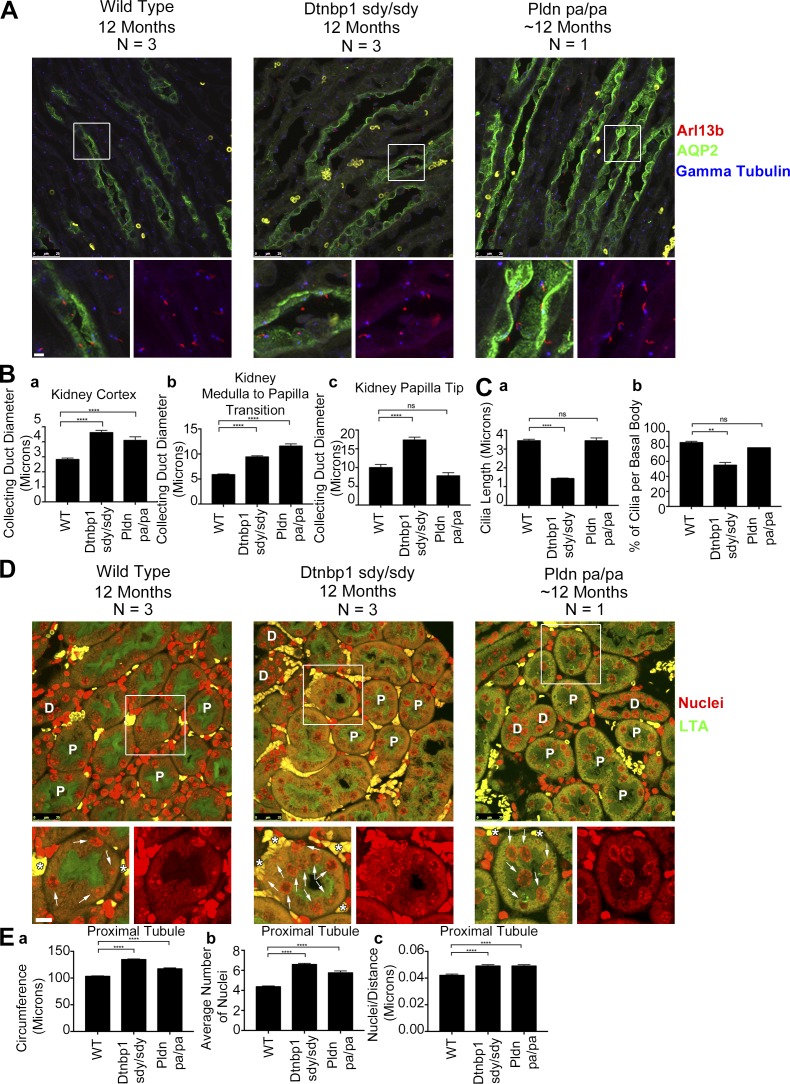Figure 6.
Dtnbp1sdy/sdy and Pldnpa/pa mice have mildly cystic kidneys. (A) Selected confocal images of 12-mo-old wild-type, Dtnbp1sdy/sdy, and Pldnpa/pa mouse kidney sections stained with cilia marker Arl13b antibody (red), collecting duct marker AQP2 antibody (green), and basal body marker γ tubulin antibody (blue). Bars, 25 µm. Insets are 285% enlargements. (B) Quantification of mean collecting duct diameters in three regions of the kidney; (Ba) cortex (wild-type and Dtnbp1sdy/sdy n = 183 collecting ducts per group, Pldnpa/pa n = 61 collecting ducts), (Bb) medulla to papilla transition (wild-type and Dtnbp1sdy/sdy n = 183 collecting ducts per group, Pldnpa/pa n = 61 collecting ducts), and (Bc) tip of the papilla (wild-type and Dtnbp1sdy/sdy n = 33 collecting ducts per group, Pldnpa/pa n = 11 collecting ducts). There is an increase in collecting duct diameter in the Dtnbp1sdy/sdy and Pldnpa/pa cortex and medulla-to-papilla transition. Additionally, the Dtnbp1sdy/sdy papilla tip collecting duct diameter is wider. (C) Quantification of mean kidney cilia length and the percentage of cilia per basal body. (Ca) Wild-type and Dtnbp1sdy/sdy n = 300 cilia per group, Pldnpa/pa n = 100 cilia. Cilia in the Dtnbp1sdy/sdy kidneys are shorter compared with control. (Cb) Wild-type and Dtnbp1sdy/sd n = 315 basal bodies per group, Pldnpa/pa n = 105 basal bodies. Percentage cilia per basal body is reduced in the Dtnbp1sdy/sdy kidneys. (D) Selected confocal images of 12-mo-old wild-type, Dtnbp1sdy/sdy, and Pldnpa/pa kidney sections stained with proximal tubule marker Lotus tetragonolobus agglutinin (LTA; green) and nuclei with Dapi (red). Most tubules are proximal, and some are marked with “P.” The few distal convoluted tubules are marked with “D.” Arrows label proximal tubule nuclei, and asterisks indicate red blood cells. Bars, 25 µm. Insets are 172% enlargements. (E) Quantification of mean kidney proximal tubule nuclei circumference, mean number of proximal tubule nuclei, and nuclei number per proximal tubule circumference. Wild-type and Dtnbp1sdy/sdy n = 225 proximal tubules per group, Pldnpa/pa n = 75 proximal tubules. (Ea) Dtnbp1sdy/sdy and Pldnpa/pa proximal tubules have an increased circumference. (Eb) Dtnbp1sdy/sdy and Pldnpa/pa proximal tubules have an increase in the mean number of nuclei. (Ec). Increase in nuclei number per proximal tubule circumference. n = 3 mice per wild-type and Dtnbp1sdy/sdy groups and n = 1 mouse per Pldnpa/pa group. Tissue from the wild-type and Dtnbp1sdy/sdy mice was harvested at precisely 12 mo of age. Two of the three Pldnpa/pa mice died of a known lung fibrosis phenotype during the aging process. Tissue from the remaining Pldnpa/pa mouse was harvested at 11 mo and 19 d of age. Error bars are SEM. Data were analyzed using one-way ANOVA and the Bonferroni multiple-comparisons test. **, P < 0.01; ***, P < 0.001; ****, P < 0.0001.

